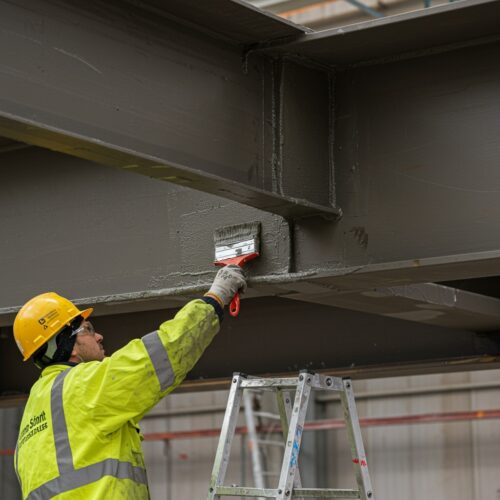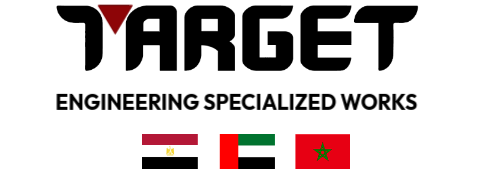Fire Proofing
Fire Proofing Services in Egypt & Morocco – UAE | Target Engineering
Intumescent and Cementitious Fire Protection for Steel Members
1. Intumescent Fire Protection
- Composition: Typically a paint-like coating (solvent-based, water-based, or epoxy) applied to steel surfaces.
- Mechanism: Expands (swells) when exposed to high heat, forming a thick, insulating char layer that protects the steel from rapid temperature rise.
- Application: Applied via spray, brush, or roller. Available in thin-film (decorative) or thick-film (higher fire resistance) forms.
- Advantages:
- Aesthetic appeal (can be painted over, suitable for exposed steel in commercial spaces).
- Lightweight and space-efficient.
- Easier retrofitting and application in complex geometries.
- Disadvantages:
- May degrade under UV exposure or harsh environments without proper topcoats.
- Generally shorter fire resistance durations (1–2 hours) compared to cementitious.
- Higher cost per unit, though labor may be lower.
- Uses: Offices, hotels, and residential buildings where visual appeal is prioritized.
2. Cementitious Fire Protection
- Composition: Cement-based mixtures, often combined with vermiculite or gypsum, applied as sprays or pre-formed boards.
- Mechanism: Provides passive insulation through inherent fire-resistant properties, absorbing heat and delaying steel temperature rise.
- Application: Sprayed directly onto steel (often using mechanical equipment) or installed as cladding.
- Advantages:
- High fire resistance (up to 4+ hours depending on thickness).
- Durable in harsh environments (moisture, chemicals, outdoor use).
- Cost-effective material, though labor-intensive.
- Disadvantages:
- Bulky appearance, unsuitable for exposed architectural steel.
- Adds significant weight and may require structural adjustments.
- Longer curing times and potential for cracking.
- Uses: Industrial plants, parking garages, tunnels, and structural elements where aesthetics are secondary.
Key Comparisons
- Fire Resistance: Cementitious generally offers longer protection (2–4+ hours) versus intumescent (1–2 hours).
- Aesthetics: Intumescent is preferred for visible structures; cementitious is utilitarian.
- Environment: Cementitious excels in harsh conditions; intumescent may require protective topcoats outdoors.
- Cost: Intumescent has higher material costs but lower labor; cementitious is cheaper material-wise but labor-intensive.
Selection Considerations
- Fire Rating Requirements: Governs thickness and material choice.
- Exposure Conditions: Outdoor, humidity, or chemical exposure favor cementitious.
- Structural Impact: Weight of cementitious may necessitate design adjustments.
- Regulations: Compliance with standards (ASTM E119, UL listings) is critical.
Conclusion
Intumescent coatings are ideal for aesthetic, lightweight applications with moderate fire resistance, while cementitious systems provide robust, long-duration protection in demanding environments. The choice hinges on fire resistance needs, environmental conditions, structural constraints, and design priorities. Both methods are essential for ensuring steel integrity during fires, adhering to safety standards globally.
Intumescent Paints
Cementitious Paints

